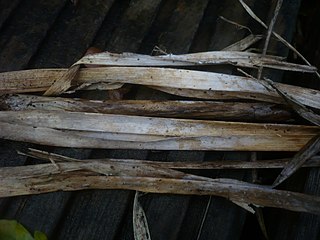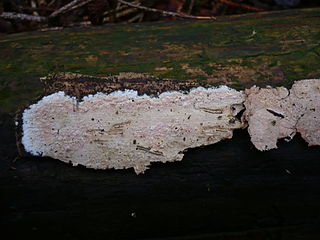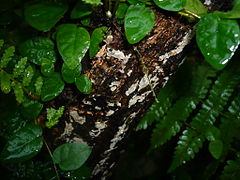
The Polyporales are an order of about 1800 species of fungi in the division Basidiomycota. The order includes some polypores as well as many corticioid fungi and a few agarics. Many species within the order are saprotrophic, most of them wood-rotters. Some genera, such as Ganoderma and Fomes, contain species that attack living tissues and then continue to degrade the wood of their dead hosts. Those of economic importance include several important pathogens of forest and amenity trees and a few species that cause damage by rotting structural timber. Some of the Polyporales are commercially cultivated and marketed for use as food items or in traditional Chinese medicine.

The Russulaceae are a diverse family of fungi in the order Russulales, with roughly 1,900 known species and a worldwide distribution. They comprise the brittlegills and the milk-caps, well-known mushroom-forming fungi that include some edible species. These gilled mushrooms are characterised by the brittle flesh of their fruitbodies.

The Clavulinaceae are a family of fungi in the order Cantharellales. The family is not well defined, but currently comprises species of clavarioid fungi as well as some corticioid fungi. These species are nutritionally diverse, some being ectomycorrhizal, others wood-rotting saprotrophs, others lichenized, and yet others lichenicolous.

The Agaricomycetes are a class of fungi in the division Basidiomycota. The taxon is roughly identical to that defined for the Homobasidiomycetes by Hibbett & Thorn, with the inclusion of Auriculariales and Sebacinales. It includes not only mushroom-forming fungi, but also most species placed in the deprecated taxa Gasteromycetes and Homobasidiomycetes. Within the subdivision Agaricomycotina, which already excludes the smut and rust fungi, the Agaricomycetes can be further defined by the exclusion of the classes Tremellomycetes and Dacrymycetes, which are generally considered to be jelly fungi. However, a few former "jelly fungi", such as Auricularia, are classified in the Agaricomycetes. According to a 2008 estimate, Agaricomycetes include 17 orders, 100 families, 1147 genera, and about 21000 species. Modern molecular phylogenetic analyses have been since used to help define several new orders in the Agaricomycetes: Amylocorticiales, Jaapiales, Stereopsidales, and Lepidostromatales.

The Corticiaceae are a family of fungi in the order Corticiales. The family formerly included almost all the corticioid fungi, whether they were related or not, and as such was highly artificial. In its current sense, however, the name Corticiaceae is restricted to a comparatively small group of mainly corticioid genera within the Corticiales, though the family is as yet not well defined.

The Phanerochaetaceae are a family of mostly crust fungi in the order Polyporales.

The Physalacriaceae are a family of fungi in the order Agaricales. Species in the family have a widespread distribution, ranging from the Arctic, (Rhizomarasmius), to the tropics, e.g. Gloiocephala, and from marine sites (Mycaureola) and fresh waters (Gloiocephala) to semiarid forests (Xerula).
Candelabrochaete is a genus of crust fungi in the family Phanerochaetaceae.

Cymatoderma is a widely distributed genus of poroid fungi in the family Meruliaceae.
Hjortstamia is a genus of poroid fungi in the family Phanerochaetaceae. It was circumscribed by French mycologists Jacques Boidin and Gilles Liège in 2003. Miettinen and colleagues consider Hjortstamia to be a taxonomy of Phlebiopsis based on molecular phylogenetics.

Hyphoderma is a genus of crust fungi in the family Meruliaceae. It was circumscribed by German botanist Karl Friedrich Wilhelm Wallroth in 1833.

Hypochnicium is a genus of corticioid fungi in the family Meruliaceae. The genus was circumscribed by mycologist John Eriksson in 1958.

{{Taxobox | image = Stereopsis humphreyi 56449.jpg | image_width = 240px | image_caption = Stereopsis humphreyi | regnum = Fungi | divisio = Basidiomycota | classis = Agaricomycetes | ordo = Stereopsidales | familia = Stereopsidaceae | familia_authority = Sjökvist, E.Larss., Pfeil & K.H.Larss. (2013) | genus = Stereopsis | genus_authority = D.A.Reid (1965) | type_species = Stereopsis radicans | type_species_authority = (Berk.) D.A.Reid (1965) | subdivision_ranks = Species | subdivision = }}

Dentocorticium is a genus of six species of poroid fungi in the family Polyporaceae. The genus was revised in 2018, with several new species added and some older species transferred to other genera, based on phylogenetic analyses.

Epithele is a genus of crust fungi in the family Polyporaceae.

The corticioid fungi are a group of fungi in the Basidiomycota typically having effused, smooth basidiocarps that are formed on the undersides of dead tree trunks or branches. They are sometimes colloquially called crust fungi or patch fungi. Originally such fungi were referred to the genus Corticium and subsequently to the family Corticiaceae, but it is now known that all corticioid species are not necessarily closely related. The fact that they look similar is an example of convergent evolution. Since they are often studied as a group, it is convenient to retain the informal (non-taxonomic) name of "corticioid fungi" and this term is frequently used in research papers and other texts.

Amylocorticiales is an order of fungi in the class Agaricomycetes. The order was circumscribed in 2010 to contain mostly resupinate (crust-like) forms that have been referred to genera Anomoporia, Amyloathelia, Amylocorticiellum, Amylocorticium, Amyloxenasma, Anomoloma, Athelia, Athelopsis, Ceraceomyces, Hypochniciellum, Leptosporomyces and Serpulomyces.

Xenasma is a genus of corticioid fungi in the order Polyporales. It was circumscribed by mycologist Marinus Anton Donk in 1957.

Amylostereum is the single genus in the fungal family Amylostereaceae. The genus currently comprises four saprotrophic and parasitic species, which live off living or dead wood. The Amylostereaceae cause white rot in the wood by disintegrating the tissue component lignin. They produce crust-like, partially wavy fruit bodies on the surface of infested trees, which are similar to those produced by Stereum species.
The Stereopsidales are an order of fungi in the class Agaricomycetes. It was first described in 2014 to contain the genera Stereopsis, which was until then classified in the order Polyporales, and Clavulicium, which was until then classified in the order Cantharellales. Molecular phylogenetics analysis showed these two genera to belong together in their own order. This order might belong in the subclass Phallomycetidae, but this relationship was poorly supported. The Stereopsidales contain corticoid fungi and stalked, funnel shaped fungi (Stereopsis). They are united by features of their spores, which have refractive contents, and become angular and amber-like as they dry. All known members also possess basidia with two sterigmata, although this is also a feature of fungi in many other orders.

















